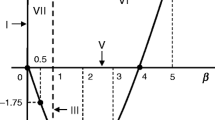Abstract
This article aims to test the relevance of learning throughgenetic algorithms, in contrast to fixed R&D rules, in a simplifiedversion of the evolutionary industry model of Nelson and Winter.These two R&D strategies arecompared from the points of view of industry performance(welfare) and firms' relative performance (competitive edge):simulations results clearly show that learning is a source oftechnological and social efficiency as well as a means formarket domination.
Similar content being viewed by others
References
Ballot, G. and Taymaz, E. (1999). Technological change, learning and macroeconomic coordination: An evolutionary model. Journal of Artificial Societies and Social Simulation, http://www.soc.surrey.ac.uk/JASS/2/2/3.html, 2(2)
Brenner, T. (1998). Can evolutionary algorithms describe learning process? Journal of Evolutionary Economics (8), 271–283.
Goldberg, D.E. (1991). Genetic Algorithms. Addison-Wesley, Reading: MA.
Holland, J.H., Holyoak, K.J. and Thagard, P.R. (1989). Induction of Inference, Learning, and Discovery. MIT Press, Cambridge:MA.
Jonard, N. and Yildizoglu, M. (1989). Technological diversity in an evolutionary industry model with localized learning and network externalities. Structural Change and Economic Dynamics 9(1), 35–55.
Knight, F.H. (1912). Risk, Uncertainty and Profits. Number Reprint, Chicago University Press. Chicago.
Kwasnicki, W. and Kwasnicka, H. (1992). Market, innovation, competition. An evolutionary model of industrial dynamics. Journal of Economic Behavior and Organization 19, 343–368.
Nelson, R.R. and Winter, S. (1982). An Evolutionary Theory of Economic Change. The Belknap Press of Harvard University, London.
Oltra, V. and Yildizoglu, M. (1998). Expectations and adaptive behaviour: the missing trade-off in models of innovation. Mimeo, BETA. Universite Louis Pasteur, Strasbourg.
Silverberg, G., Dosi, G. and Orsenigo, L. (1988). Innovation, diversity and diffusion: a self-organization model. Economic Journal 98, 1032–1054.
Silverberg, J. and Verspagen, B. (1996). From the artificial to the endogenous. In: M. Helmstadter and Ernst Perlman (eds.), Behavior Norms, Technological Progress, and Economic Dynamics: Studies in Schumpeterian economics. University of Michigan Press, Ann Arbor.
Simon, H.A. (1958). The role of expectations in adaptive or behavioristic model. In: Bowman, M.J (ed.), Expectations, Uncertainty and Business Behavior. Social Science Council, New York. pp. 49–58.
Simon, H.A. (1976). From substantial to procedural rationality. In: Latsis, S.J. (ed.), Method and Appraisal in Economics. Cambridge University Press, Cambridge, pp. 129–148.
Vriend, N. (1998). An illustration of the essential difference between individual and social learning, and its consequences for computational analyses. Journal of Economic Dynamics and Control 24(1), 1–19.
Watson, C.J., Billingsley, D.J., Croft, D.J., and Huntsberger, D.V. (1993). Statistics for Management and Economics, 5th edition, Allyn and Bacon, Boston.
Author information
Authors and Affiliations
Rights and permissions
About this article
Cite this article
Yildizoglu, M. Competing R&D Strategies in an Evolutionary Industry Model. Computational Economics 19, 51–65 (2002). https://doi.org/10.1023/A:1014945023982
Issue Date:
DOI: https://doi.org/10.1023/A:1014945023982




